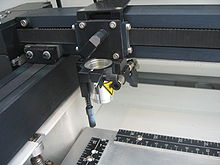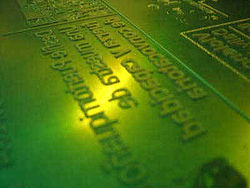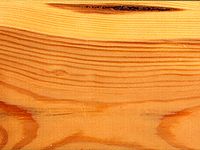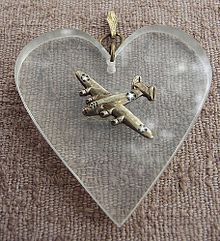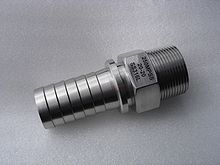
Laser engraving, and laser marking, is the practice of using lasers to engrave or mark an object. The technique does not involve the use of inks, nor does it involve tool bits which contact the engraving surface and wear out. These properties distinguish laser engraving from alternative engraving or marking technologies where inks or bit heads have to be replaced regularly.
The impact of laser engraving has been more pronounced for specially-designed "laserable" materials. These include laser-sensitive polymers and novel metal alloys.
The term laser marking is also used as a generic term covering a broad spectrum of surfacing techniques including printing, hot-branding and laser bonding. The machines for laser engraving and laser marking are the same, so that the two terms are usually interchangeable.
Machines equipped with Laser engraving
| | A laser engraving machine can be thought of as three main parts: a laser, a controller, and a surface. The laser is like a pencil - the beam emitted from it allows the controller to trace patterns onto the surface. The controller (usually a computer) controls the direction, intensity, speed of movement, and spread of the laser beam aimed at the surface. The surface is picked to match what the laser can act on. |
----------------------------------------------------------------------------------------------------------------------------------------------------------------------
Industrial applications
Direct laser engraving of flexographic plates and cylinders
| | Direct laser engraving of flexographic printing cylinders and plates has been an established process since the 1970s. This first began with the use of a carbon dioxide laser used to selectively ablate or evaporate a variety of rubber plate and sleeve materials to produce a print ready surface without the use of photography or chemicals. As a competitive process, more recently laser system have been introduced to selectively engrave the thin opaque black layer of a specially produced photopolymer plate or sleeve |
Direct photopolymer laser imaging
Closely related is the direct imaging of a digital flexo plates or sleeves 'in-the-round' on a fast-rotating drum, or cylinder. This is carried out on a platesetter integrated within a digital prepress workflow, that also supports digital proofing.
Laser engraving of anilox rolls
Prior to 1980 anilox rolls were produced by a variety of mechanical processes. These metal anilox rolls were sometimes sprayed with ceramic to prolong their life in the flexographic printing press.
Sub-surface laser engraving (SSLE)
Sub-surface laser engraving is the process of engraving an image in a transparent solid material by focusing a laser below the surface to create small fractures. Such engraved materials are of high-grade optical quality (suitable for lenses, with low dispersion) to minimize distortion of the beam.
-------------------------------------------------------------------------------------------------------------------------------------------------------------------------
Materials That Can Be Engraved
| Natural materials Directly "burning" images on wood were some of the first uses of engraving lasers. The laser power required here is often less than 10 watts depending on the laser being used as most are different. Hardwoods like walnut, mahogany and maple produce good results. Softwoods can be judiciously engraved but tend to vaporize at less-consistent depths Plastics Standard cast acrylic plastic, acrylic plastic sheet, and other cast resins generally laser very well. A commonly engraved award is a cast acrylic shape designed to be lasered from the back side. Kevlar can be laser-engraved and laser-cut. However, Kevlar does give off extremely hazardous fumes (cyanide gas) when it is vaporized. Metals The best traditional engraving materials started out being the worst laser-engravable materials. This problem has now been solved using lasers at shorter wavelengths than the traditional 10,640 nm wavelength CO2 laser. Coated metals However, the same conduction that works against the spot vaporization of metal is an asset if the objective is to vaporize some other coating away from the metal. Spray coatings can be obtained for the specific use of laser engraving metals, these sprays apply a coating that is visible to the laser light which fuses the coating to the substrate where the laser passed over. Stone and glass Stone and glass do not turn gaseous very easily. As expected, this makes them generally a better candidate for other means of engraving, most notably sandblasting or cutting using diamonds and water. But when a laser hits glass or stone, something else interesting happens: it fractures. | |
| Scots Pine, a typical and well-known softwood | |
| | |
| era Lucite sweetheart pin | |
| | |
| Laser on Stainless Steel |
References: wikipedia
Written by Nicolas Yang
